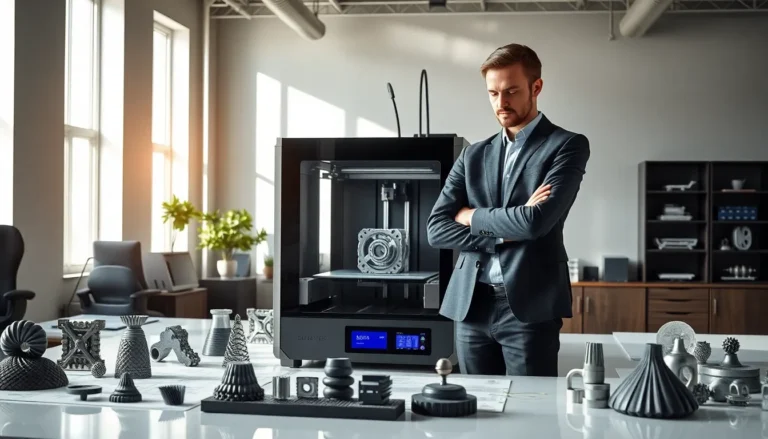Table of Contents
ToggleIn today’s rapidly transforming tech landscape, the chatter around emerging technologies like Robotic Process Automation (RPA) can get downright overwhelming. If you’ve ever found yourself wondering where RPA fits in among the flashy new kids on the block like AI, IoT, and blockchain, you’re not alone. Grab your favorite caffeinated beverage, and let’s jump into this intriguing intersection where automation meets innovation, all while keeping our wits about us (and maybe even having a chuckle along the way).
Understanding Robotic Process Automation (RPA)

Robotic Process Automation, or RPA, is a technology that allows organizations to automate routine tasks by using software robots. These robots mimic human interactions with digital systems to execute business processes. Imagine a fabulous assistant who can work 24/7, doesn’t need coffee breaks, and will never accidentally hit ‘reply all’ on an email chain. RPA helps companies streamline operations, reduce errors, and eventually save money.
RPA is particularly effective in industries like finance, healthcare, and logistics where processes are not only repetitive but also time-sensitive. Activities such as invoice processing, data entry, and customer support are prime candidates for automation. It’s impressive how RPA can free up human employees to focus on more strategic, value-added tasks. In essence, RPA acts like a powerful tool in a digital toolbox, waiting to be unleashed.
The Role of AI and Machine Learning
Artificial Intelligence (AI) and Machine Learning (ML) are crucial players in the tech universe, often seen as the brains behind operations. While RPA focuses on automating specific tasks, integrating it with AI and ML transforms the robot from a basic worker bee into a hive of intelligent decision-making.
AI allows RPA to analyze data, learn from outcomes, and improve performance over time. For example, when RPA processes customer data for insights, AI can identify patterns and offer recommendations. This synergy doesn’t just increase efficiency: it also enhances accuracy and effectiveness within an organization.
So, what does this mean for businesses? By combining RPA with AI, they can achieve a more capable workforce. That means fewer errors, quicker responses, and higher customer satisfaction. Think of it as upgrading from a bicycle to a high-speed train: you’re not just moving faster, but also adapting to complex routes.
Integration with Cloud Computing
Cloud computing has ushered in a new era of accessibility and flexibility for businesses. RPA, when combined with cloud technologies, becomes even more powerful. Instead of deploying RPA on local servers, companies can carry out cloud-based RPA solutions that can be accessed from anywhere.
This not only minimizes IT infrastructure costs but also scales operations swiftly. Picture a marketing team that needs to launch a campaign overnight. With cloud-based RPA, they can automate data collection from social media, analyze results, and deploy targeted advertising, all before breakfast.
Also, the cloud enables integration with other applications, ensuring that RPA can operate seamlessly within the business ecosystem. Organizations can accumulate vast amounts of data, enhance productivity, and maintain flexibility without being chained to their desks.
Complementing Internet of Things (IoT) Solutions
The Internet of Things (IoT) has brought connectivity to our everyday devices, making our lives a lot easier, and a bit busier. RPA complements IoT by automating processes linked to the data generated from smart devices.
For example, imagine a smart building that uses sensors to monitor energy usage. RPA can analyze this data, identify opportunities for optimization, and even make adjustments automatically, like switching off lights in empty rooms. This not only conserves resources but also minimizes manual monitoring efforts.
When RPA works in tandem with IoT, organizations can leverage real-time data for faster decision-making. This means they can respond to challenges and opportunities more swiftly than ever. RPA effectively acts as the bridge, connecting the dots between several IoT applications to streamline operations and enhance functionality.
RPA and Blockchain Technology
Blockchain technology, with its emphasis on transparency and security, may seem like a world apart from RPA. But, integrating RPA with blockchain can yield remarkable benefits. RPA can automate the processes involved in managing blockchain transactions, from data entry to compliance checks.
For instance, in supply chain management, combining RPA with blockchain ensures that every transaction is not only recorded but also verified in real-time. Imagine needing to trace the origins of a product, RPA can automatically pull that data from the blockchain, streamlining the auditing process significantly.
This automation minimizes human intervention, thereby reducing the risk of errors and enhancing data integrity. When RPA and blockchain technology come together, organizations can benefit from seamless and secure operations that enhance trust and accountability.
RPA in the Context of Digital Transformation
Digital transformation isn’t just a buzzword: it’s a necessity for businesses aiming to thrive in a competitive market. RPA plays a pivotal role in facilitating this transformation. By automating routine tasks, RPA frees up human talent to engage in innovation and creative problem-solving.
Besides, RPA streamlines processes across various business units, leading to greater collaboration and agility. As companies integrate RPA into their digital transformation strategies, they often discover new efficiencies and opportunities for growth. Think of RPA as the spark that ignites the fire of transformation, lighting the way for other technologies to follow suit.
Eventually, organizations that leverage RPA within their digital transformation journey are better positioned to adapt and thrive in an increasingly complex market landscape.
Future Trends: RPA and Emerging Technologies
As we look ahead, the interplay between RPA and emerging technologies is bound to evolve further. With advancements in AI, IoT, and big data, RPA will likely become more sophisticated, allowing for complex decision-making and predictive analytics.
Another trend to consider is the rise of hyperautomation, where organizations seek to automate as many processes as possible. RPA will serve as a foundational layer in this quest, driving efficiency and innovation across sectors. With each leap in technology, RPA’s role will expand, allowing organizations to embrace more automated workflows.
Also, as businesses become more data-driven, the integration of RPA with analytics tools will become increasingly essential. Companies will leverage RPA to enhance their data processing capabilities, enabling them to extract valuable insights for better decision-making.
In a nutshell, the future of RPA is bright, teeming with potential to redefine how organizations operate and innovate.




